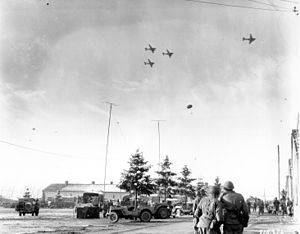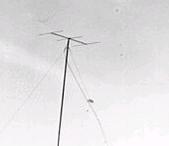
US Army Signal Corps photo, Wikipedia.
This photo was taken 70 years ago today, 26 December 1944, during the siege of Bastogne, part of the Battle of the Bulge. It was taken by a U.S. Army Signal Corps photographer, and shows troops of the 101st Airborne Division as they watch C-47s drop supplies to them. Of course, if you’re a ham, your eyes zero in on the antenna, shown below, and you see what appears to be a horizontally polarized VHF Yagi antenna on top of a tall mast. If you’re like me, you wonder what it is and what it’s doing there.
I apparently wasn’t the first to ask the question, since it had already been asked and answered on K4CHE’s site. The antenna in question is, indeed, a VHF Yagi, and it was part of a telephone relay system operating with 50 watts between 70-100 MHz. This was an FM full-duplex relay that could handle one voice conversation or four teletype channels. It was linked to telephone circuits and represented a low-cost alternative to stringing phone lines. A diagram of the antenna system, known as the AS-19/TRC-1, is shown below.

AS-19/TRC-1, Radio News, Jan. 1946.
Later models had greater capacity, such as the one whose operating manual is available at this link. The range obviously depended on the terrain, but was normally used for links of 25-100 miles. The technical details are discussed in detail in the Radio News link below. Not surprisingly, the Yagi antenna was not referred to by that Japanese name at the time. It’s referred to as a “double H” type antenna.
I haven’t been able to find it, but one of the sources above indicated that a ham magazine published an article for converting this antenna to 6 meter use.
References
- The Army’s Radio Relay Equipment, page 25, Radio News, Jan. 1946.
- Communications Systems at vectorsite.net
- History of First Radio Relay Squadron
- Communications in the Southwest Pacific: To Mid-1944
- Directional Radio Relays, Popular Science, Jan. 1946.
Click Here For Today’s Ripley’s Believe It Or Not Cartoon
![]()


Pingback: D-Day Army Radio Link | OneTubeRadio.com